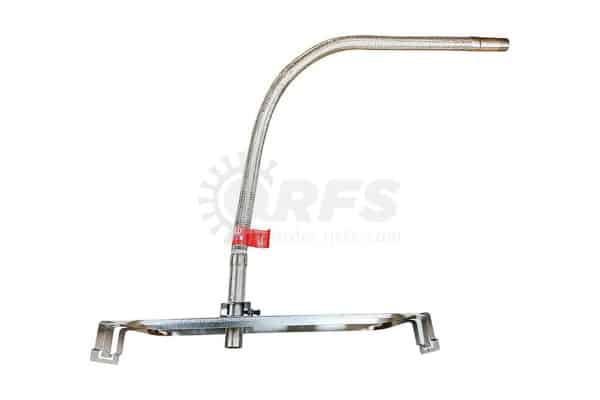Use our guide to select flex sprinkler drops for your fire sprinkler installation
Fire sprinkler flex drops have claimed their place as a key innovation in the fire protection industry. In areas prone to earthquakes or buildings with dropped ceilings susceptible to “ceiling creep,” flexible sprinkler drops can keep sprinklers from shifting out of place and malfunctioning during a fire. They also make installation in certain spaces easier.
But with dozens of manufacturers and hundreds of assemblies to choose from, how do installers select the right fire sprinkler flex drops for a job?
In this first installment of our two-part series on flexible sprinkler drops, we help contractors make informed decisions about the right product to purchase for their installations. QRFS examines what makes one drop different from another, with a focus on rated flexibility. We will also review profiles of U.S.-based manufacturers with UL-approved assemblies like FlexHead, VICFLEX, and more.
Stay tuned for our next installment, where we explore NFPA requirements for flexible sprinkler drop installations.
Already know which flexible sprinkler drop you want to purchase? Skip directly to our selection of FlexHead and SprinkFLEX flexible sprinkler head drops.
When should I use fire sprinkler flex drops in a fire sprinkler system?
Putting fire sprinkler heads in the right spot is critical—but unfortunately, it’s often challenging. Traditionally, installers rely on a series of hard pipes and fittings that must be precisely measured to connect sprinkler heads to their water supply.
But with comparable costs to contractors and an array of other benefits, flexible metal hose assemblies are surging in popularity. They solve many of the installation issues associated with suspended ceilings, install faster than sprinkler armovers, and help protect sprinkler systems against earthquakes.
Using flexible tubes, these assemblies connect rigid branch lines—the pipes supplying water directly to sprinklers—to sprinkler heads in the simplest manner available. And while traditional piping remains rigid, these flexible tubes allow sprinklers to move along with suspended ceilings or seismic events and stay in the appropriate position.
These advantages have made flexible drops common in large-scale fire sprinkler installations in malls, airports, and other sizable buildings. Some models, like Victaulic’s VicFlex, are even tailored to the special ceilings used in semiconductor manufacturing or research laboratories.
Key advantages of flexible sprinkler drops include:
- Reduced labor costs. Fire sprinkler flex drops can significantly slash system installation times. As many as seven distinct pieces can comprise a single return bend on hard branch piping—and some of those pieces typically need to be cut and joined. The same assembly and coordination isn’t required to locate sprinkler drops in specific positions within a ceiling.
- Quicker project completions. Time savings enjoyed by easy flex sprinkler drop installations can lead to faster completion of projects.
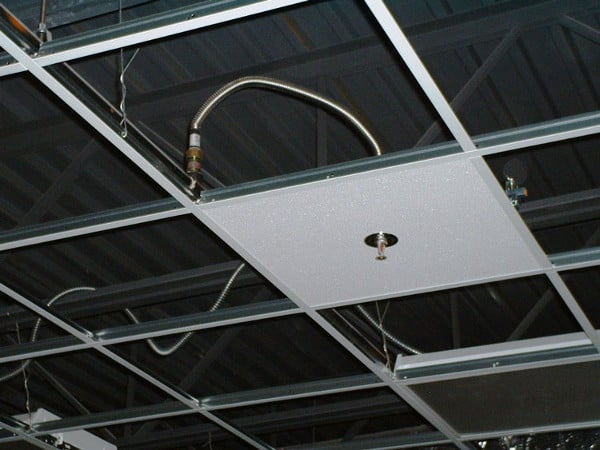
- Allow for “ceiling creep” in suspended ceilings. Suspended—also known as false or dropped—ceilings, are a commonly used, cost-effective way of concealing necessary infrastructure in a building. But suspended ceilings can present problems for installers, making it hard to precisely place sprinklers because they must make their way through ceiling panels using a series of pipes and fittings. Suspended ceilings tend to move after they’re put in place as well, causing sprinklers to slowly become misaligned. That can be a dangerous issue: openings caused by shifting sprinklers may allow heat to seep into above-ceiling spaces instead of gathering around a sprinkler’s thermal element, causing it to deploy dangerously late. Movement also can lead to obstructions between the ceiling’s new position and fixed-in-place sprinklers. Fire sprinkler flex drops move with suspended ceilings, keeping sprinklers in the proper position.
- Seismic performance. Earthquakes can cause catastrophic failures in fire sprinkler systems that aren’t properly braced or flexible. Sprinkler heads collide with ceilings, fittings break as pipes bend, and bolts supporting pipes slip or snap. In a seismic event, sprinklers on flexible drops will move with the ceiling. Testing conducted by the Network for Earthquake Engineering Simulation found that sprinkler armovers and ceiling drops are the most vulnerable points within fire sprinkler systems during earthquakes. But tests found that flexible fire sprinkler drops significantly reduced contact between pipes and the ceiling—a major cause of damage.
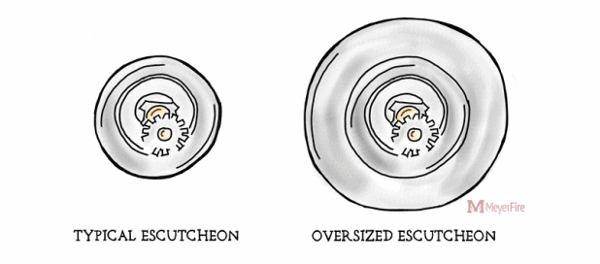
- No oversized escutcheons required. Unless a ceiling in an earthquake-prone area is rigidly braced, ASCE 7: Minimum Design Loads and Associated Criteria for Buildings and Other Structures requires sprinklers to have clearances on all sides that can range from ¼ inch to 1 inch to accommodate seismic motion. The exact size depends upon the type and seismic risk of the building. To meet this requirement, installers must either use an oversized escutcheon to cover the required clearance, a swing joint above the sprinkler, or a flexible drop. While each solution meets code, flexible drops can accommodate the mandated movement without oversized escutcheons, which some consider an eyesore.
- Easier remodels. The use of flexible sprinkler assemblies make it easy to relocate sprinklers within a short distance during ceiling modifications, without re-cutting, attachment, or demolition of existing pipe and fittings.
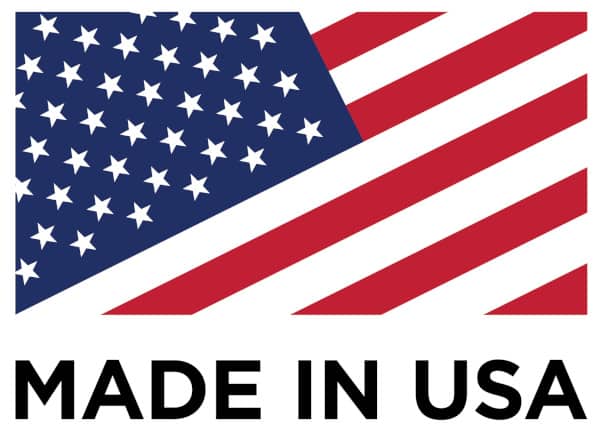
Made in the USA: fire sprinkler flex drops from American manufacturers
Now that you’ve decided to replace hard-pipe connections between sprinkler heads and branch lines with flexible hose assemblies, the next step is selecting the right product. But with more than 40 manufacturers worldwide selling products certified by UL for use as flexible fire sprinkler hose, the choices can be overwhelming.
Many flexible sprinkler drop manufacturers have long-standing reputations as leaders in the fire sprinkler industry, including Tyco, Victaulic, and RASCO. But other manufacturers specialize in pipes, fittings, and flexible drops specifically. Anvil International’s FlexHead and SprinkFLEX, Gateway Tubing’s Sidewinder, and Aleum’s Quickonnect are just a few of the leading names in that category.
QRFS customers often express a preference for American-made goods, which significantly narrows the list of options. U.S.-based manufacturers of UL-listed flexible fire sprinkler head drops include:
- Anvil International (Exeter, NH)
- ARGCO (Fort Smith, AR)
- Gateway Tubing (Rolla, MO)
- Victaulic (Easton, PA)
Let’s examine the differences between the products offered by each of these manufacturers. While the offerings share much in common, each manufacturer has a different selection of lengths, approvals, K-factors, and bend characteristics that should be considered before making a final selection.
Friction loss: a key consideration for choosing fire sprinkler flex drops
There’s a critical factor to consider that applies across all fire sprinkler drops: friction loss. Moving water generates friction as it flows through pipes or tubes, causing pressure to drop. This loss grows as the length or roughness of the pipe’s or tube’s interior increases, as the diameter decreases, or as the pipe or tube bends.
Sprinkler drop manufacturers provide a measure of friction loss to help installers choose a product that allows adequate water flow to each sprinkler head. The resistance created by a drop’s tubing is measured in terms of equivalent lengths of 1-inch schedule 40 pipe.
Review those measurements carefully to ensure that your sprinkler heads will receive enough water pressure during a fire. Some 3’ FlexHead drops, for example, generate as much friction as 24’ of pipe, while the same length of VicFlex Series AH2 generates the equivalent of 21’ pipe.
Measurements of friction loss are typically provided by third-party certification agencies UL or FM. Both groups test fire sprinkler flex drops in the most challenging scenario, with as many sharp, 90-degree bends as possible.
However, keep in mind that since the certification agencies test in slightly different ways, their results aren’t exactly apples to apples. FM approvals offer installers the greatest detail, providing friction loss equivalents that vary according to the K-Factor, or orifice size, of the fire sprinkler served by the hose. FM tests these flexible fire sprinkler drops at 25 gallons per minute (GPM), 30 GPM, and so on, up to 65 GPM.
UL offers a single measurement of friction loss. Previously, UL testers have taken measurements of flow rates at 7 pounds per square inch (PSI), followed by assessing flows from 10 PSI to 100 PSI in increments of 5 PSI. These measurements are averaged, leaving buyers with data that falls somewhere in the middle of FM’s measurements.
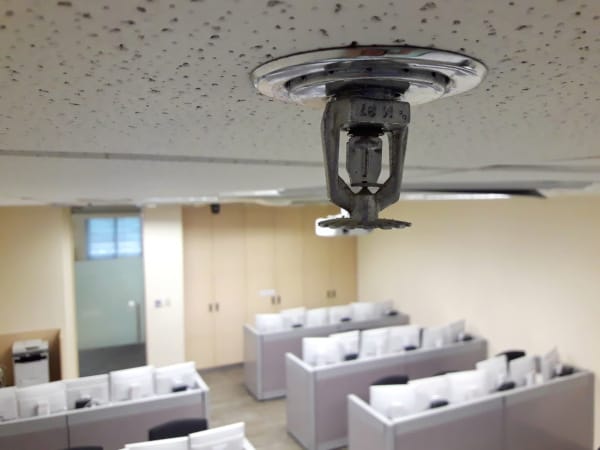
Compare rated bends, lengths, K-Factors, and more among fire sprinkler flex drop manufacturers
Let’s dig into the differences between brands.
Keep in mind that the following information is based on approvals listed in the UL Product Spec database, as well as information available on manufacturers’ websites at the time of writing. For more information, you can view UL’s listings or consult the manufacturer datasheets directly.
Anvil International (SprinkFLEX, FlexHead, SuperFlex)
With more than 150 years in the pipe hanging and hardware business, Anvil International arguably offers the most varied and well-known selection of sprinkler drops. The New Hampshire-based company has ISO-certified manufacturing facilities in four states, and the experience of fire safety titan Grinnell in its corner.
Anvil’s catalog includes more than 100 UL-listed drops and high-profile brands like FlexHead. It also has some unusual offerings, including an assembly rated for 12 bends in a mere 6’.
Lengths: 24″, 28″, 36″, 40″, 47″, 48″, 59″, 60″, 71″, 72″
K-Factor: 6K, 8.0K, 11.2K, 14.0K, 16.8K
Maximum Bends (UL): Up to 12 (2, 3, 4, 5, 8, or 12)
Minimum Bend Radius (UL): 2″-3″
Bend at Nut: SprinkFLEX fittings should not be bent within 2 1/2″ of either end
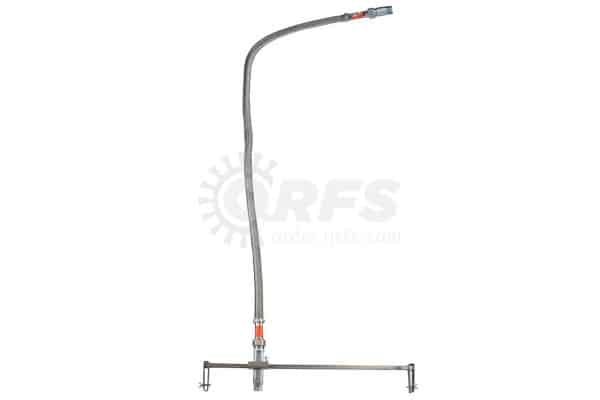
ARGCO
From its humble beginnings in an Arkansas garage almost 40 years ago, ARGCO stands out as one of a handful of manufacturers explicitly offering flexible sprinkler drops that comply with the Buy American Act. BAA requires products to be made in the U.S. from a significant portion of American-made materials. ARGCO doesn’t offer drops in the shortest length, but its products have other advantages. For instance, its standard lengths of braided and unbraided hose have higher-than-average K-factors for wet and dry fire sprinkler systems.
Lengths: 28″, 40″, 48″, 60″, 72″
K-Factor: 5K (1/2″), 14.0K (3/4″)
Maximum Bends (UL): Up to 3 depending on length
Minimum Bend Radius (UL): 4″
Bend at Nut: Unknown
Gateway Tubing (Sidewinder)
Like its name suggests, Gateway Tubing specializes in the production of flexible stainless tubing. The Missouri-based company offers the most limited selection of lengths of any manufacturer considered here. But its products have an enticing feature: Sidewinder drops include mounting assemblies that allow installers to choose a position along both the X and Y axes of ceiling tile at any position.
Lengths: 30″, 48″, 60″
K-Factor: Not Specified (Available with 1/2″ or 3/4″ outlets)
Maximum Bends (UL): 2–3 depending on the length
Minimum Bend Radius (UL): 4″
Bend at Nut: Not within 2 1/2″ inches at either end.
Victaulic (VicFlex)
Of the companies reviewed in this blog, Victaulic is the only other manufacturer that provides a selection comparable to Anvil International. With more than 100 flexible sprinkler drops in a variety of sizes, this long-established manufacturer of fire protection and piping products offers an array of highly flexible, large- and small-outlet hoses. It also includes assemblies designed specifically for applications in cleanrooms, ductwork, cold storage, and dry sprinkler systems.
Lengths: 28″, 31″, 36″, 39″, 48″, 60″, 61″, 72″
K-Factor: 6K, 8.0K, 11.2K, 14.0K
Maximum Bends (UL): Up to 12 (2, 3, 4, 5, 8, or 12)
Minimum Bend Radius (UL): 2″-4″
Bend at Nut: Varies; see data sheets
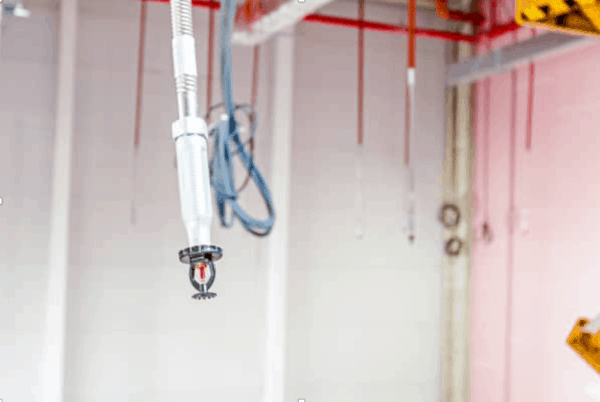
Make an informed purchase with our fire sprinkler flex drop guide
With so many flexible sprinkler drop manufacturers and assemblies to choose from, selecting the right product for a job can feel daunting. Use our guide of leading American manufacturers to uncover the information contractors need to make an informed and effective choice.
QRFS carries two lines of flexible fire sprinkler drops from Anvil International: FlexHead and SprinkFLEX. Both brand-name assemblies feature braided stainless-steel hose and approvals from UL and FM.
Our supply of Flexhead and SprinkFLEX drops are designed to fit standard fire sprinklers sizes in a variety of lengths, including:
- FlexHead assemblies in 24″, 36″, and 48″ lengths for 3/4″ sprinklers
- SprinkFLEX assemblies in 28″, 40″, 48″, and 71″ lengths for 1/2″ heads
- 59″ SprinkFLEX assemblies for both 1/2″ and 3/4″ fire sprinklers
Both brands feature stable brackets that allow sprinkler heads to install before placing the bracket in the ceiling. Our SprinkFLEX models feature a fully adjustable bracket that gives installers maximum flexibility in sprinkler head placement, while FlexHead models ship standard with a multi-port bracket that allows installers to quickly position the sprinkler in the center or at either quarter of the bracket’s width.
Compare and shop our selection of FlexHead and SprinkFLEX flexible sprinkler head drops by clicking here. Questions about flexible fire sprinkler drops? Call us at +1 (888) 361-6662 or email support@qrfs.com.
Stay tuned for the next installment in our two-part series, where we explore NFPA requirements for flexible sprinkler drop installations.
This blog was originally posted at blog.qrfs.com. Check us out at Facebook.com/QuickResponseFireSupply or on Twitter @QuickResponseFS.


